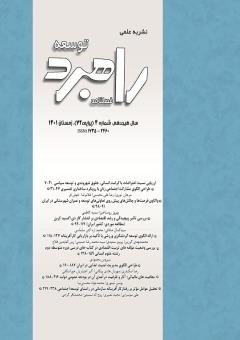طراحی الگوی مدیریت امنیت غذایی در ایران
محورهای موضوعی :
رضا اسکندری
1
,
مهربان هادی پیکانی
2
![]() ,
اکبر اعتباریان خوراسگانی
3
,
اکبر اعتباریان خوراسگانی
3
1 - دکترای تخصصی
2 - دانشگاه آزاد اصفهان
3 - دانشگاه ازاد اسلامی اصفهان (خوراسگان)
کلید واژه: کلمات کلیدی:امنیت غذایی, ایران, توسعه, الگو,
چکیده مقاله :
هدف پژوهش حاضر طراحی الگوي مدیریت امنیت غذایی در ايران با تاکید بر تجارب کشورهای موفق در این زمینه بوده است.اين پژوهش از نظرهدف،اكتشافي و از نظر روش،تلفيقي از روش هاي كيفي و كمي بود.در مرحله اول از روش كيفي و از نوع تحليل محتواي مقوله اي(استقرايي)استفاده شد و جهت جمع آوري اطلاعات از منابع مكتوب و الكترونيكي در حوزه امنيت غذايي به صورت هدفمند بهره برده شد.يافته هاي تحليل محتواي منابع بر اساس نظر كانون خبرگان(متشكل از پنج نفر از اساتيد رشته مديريت دولتي)در يك نظام استقرايي الگوي اوليه از مديريت امنيت غذايي(متشكل از 211مفهوم،61مقوله و 12 بعد) را ارائه نموده و در ادامه از طريق تكنيك دلفي و با ابزار پرسشنامه،الگوي بدست آمده در معرض قضاوت اعضاي دلفي قرار داده شد.در اين مرحله از تحقيق 12 نفر از متخصصان علمي و عملي(اعضاي هيئت علمي دانشگاه و مسئولان وزرات بهداشت)به عنوان نمونه آماري با استفاده از روش نمونه گيري هدفمند براي كانون دلفي انتخاب شدند.در مرحله بعد الگوي برآمده از كانون دلفي در يك جامعه ي بزرگتر آزمون شد.جامعه آماري در اين مرحله شامل 2600 نفر از كارشناسان صنايع غذايي مستقر در شهرك هاي صنايع غذايي اصفهان بود كه با استفاده از جدول مورگان 335 نمونه محاسبه گرديد و به روش نمونه گيري در دسترس 310 پرسشنامه جمع آوري گرديد.ارزيابي الگو از طريق تحليل عاملي تاييدي و همچنين محاسبه ي پايايي و روايي صورت گرفته است.در نهايت الگوي مديريت امنيت غذايي در ايران با170 مفهوم،58مقوله و 12 بعد بدست آمده است.
Reza eskandari Mehraban Hadipeykani Akbar Etebarian Khorasgani Abstract The purpose of the present study was to design a model of food security management in Iran, emphasizing the experiences of successful countries in this field.This research was exploratory in terms of purpose, in terms of method, a combination of qualitative and quantitative methods. In the first stage, qualitative method and categorical content analysis (Inductive) was used and written and electronic sources in the field of food security were used purposefully to collect information. Findings of content analysis based on the opinion of the Center of Experts (consisting of five professors of public administration) in a system Induction presented the initial model of food security management (consisting of 211 concepts, 61 categories and 12 dimensions) and then through Delphi technique and questionnaire, the obtained model was exposed to the judgment of Delphi members. At this stage of the research, 12 scientific and practical experts (faculty members and officials of the Ministry of Health) were selected as a statistical sample using purposive sampling method for Delphi Center. In the next stage, the model derived from Delphi center was tested in a larger community. The statistical population at this stage included 2600 food industry experts based in Isfahan food industry towns. Using Morgan table, 335 samples were calculated and 310 questionnaires were collected by available sampling method. The model was evaluated through confirmatory factor analysis as well as reliability and validity calculations. Finally, the food security management model in Iran with emphasis on The experiences of successful countries in this field have been obtained with 170 concepts, 58 categories and 12 dimensions.
